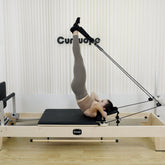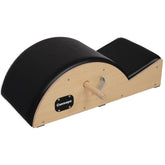How do I set up a Pilates Reformer for use? How do I adjust the springs on a Pilates Reformer?
The Pilates Reformer is a popular piece of equipment used for Pilates exercises. It consists of a carriage that slides back and forth on rails and is attached to springs that provide resistance. The Reformer also has various straps and bars that can be used for different exercises. In this article, we will discuss how to set up a Pilates Reformer for use and how to adjust the springs.

Setting Up the Pilates Reformer
Position the Reformer: Place the Reformer on a flat and stable surface, ensuring there is enough space around it for movement.
Align the Carriage: Align the carriage with the frame and ensure it slides smoothly back and forth on the rails.
Adjust the Footbar: Adjust the footbar to the desired height, ensuring it is secure and level.
Attach the Springs: Attach the springs to the carriage, ensuring they are properly secured and aligned. The number and tension of the springs will depend on the exercise being performed.
Attach the Straps: Attach the straps to the appropriate hooks on the frame and ensure they are properly secured and aligned.
Adjust the Headrest: Adjust the headrest to the desired height and angle.
Adjust the Shoulder Blocks: Adjust the shoulder blocks to the appropriate height and distance from the footbar.
Adjusting the Springs on the Pilates Reformer
Identify the Springs: The Pilates Reformer has different types of springs, including light, medium, and heavy. Each spring has a different tension level and provides a different level of resistance.
Adjust the Springs: To adjust the springs, simply slide the spring hooks up or down the risers on the frame. The higher the hook, the more tension the spring will have. To remove or add springs, simply detach or attach them to the carriage.
Test the Springs: After adjusting the springs, test them by performing a few exercises. If the resistance is too high or too low, adjust the springs accordingly.
Use a Spring Chart: Some Pilates Reformer models come with a spring chart that provides guidance on the appropriate spring tension for different exercises. If your Reformer comes with a spring chart, refer to it when adjusting the springs.
In conclusion, setting up a Pilates Reformer for use is a straightforward process that involves aligning the carriage, adjusting the footbar, attaching the springs and straps, and adjusting the headrest and shoulder blocks. Adjusting the springs on the Reformer is also easy and involves sliding the spring hooks up or down the risers on the frame. By following these steps, you can ensure your Pilates Reformer is properly set up and adjusted for a safe and effective workout.





